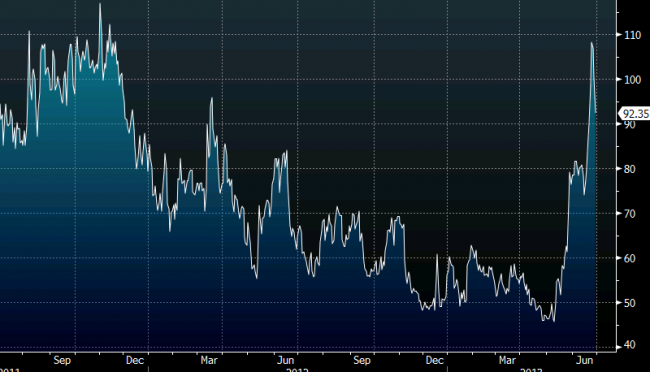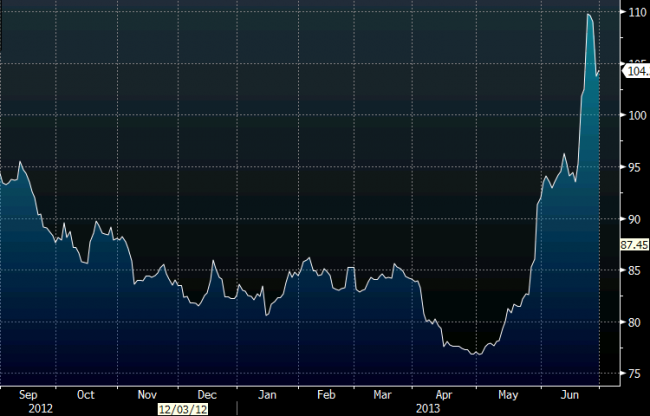Most commentary and media coverage refers to the three main markets of bonds, equities and FX. And yet there are many other markets which deserve our attention. Unfortunately they are often ignored but it is often in these more obscure financial exchanges that significant moves and early warning signs can be found.
So with respect to interest rates, many look at 10 year government bond yields (borrowing costs) to give as the main indicator of rates. But to look for indications of what central bankers are expected to do, you need to look at the short term interest rate markets. And currently it is the money markets that have grabbed my attention. In the last month or two, there has been a significant change in the expectations of central bank actions. And it’s not just in the United States, but in the UK, Europe and even China.
So the first chart to look at is the CIRVE curve. This is effectively a measure of the volatility in interest rate markets.

CIRVE 2011-2013
What you can see from this chart, is that there has been a massive increase in volatility. There is no longer a consensus of low rates forever. The increase in volatility shows that there are now more divergent views on where interest rates are going. The American CBOE (Chicago Board of Exchange) Interest Rate Volatility Index – SRVX index – shows the same, it has shot up over the last month.

So more volatility, but in what direction have markets moved? Not surprisingly given what Ben Bernanke has been saying, these markets are now predicting rates to increase earlier than they were expecting a month or so ago. But it’s not just the US, markets are telling us that they now expect central bankers all over the world to tighten a lot sooner.
In the Eurozone the move has been dramatic and clearly will have caused some players large losses. According to my Broker mate “markets had gone too far pricing Europe as Japan….the front of the Euro curves was getting mad, discounting zero rates for a long time (which) was crazy”.
So what has caused this correction over the last month and a half? Firstly it appears that markets got overly excited about the prospect of a negative deposit rates at the ECB, which is now deemed less likely. Secondly there has been slightly better EZ economic data, most recently better German IFO survey. Thirdly the message coming out of the ECB has contributed to the tightening theme – most notably that there are limitations to the effectiveness of extremely low interest rates. Add on the general environment created by the Fed reminding players that ZIRP (zero interest rate policy) is not going to last forever and there’s been a significant change in the market. Markets had been expecting another rate cut from the ECB, now, no longer.
In the UK, it is a similar story – stronger economic data over the last month or two has ensured that markets had almost moved to price in a base rate increase by the end of the year! That is just six months’ time and a lot sooner than had been expected (especially for all those with base rate tracker mortgages). It all kicked off on May 15with Mervyn King’s most optimistic speech since the start of the crisis saying that the recovery had started (together of course with the Fed’s warning about the end of QE).
However the story is complicated by the change at the top of the Bank of England. Soon to be Lord King is being replaced by the Canadian Mark Carney who starts on Monday. His arrival is causing uncertainty and extra volatility as markets have not yet got his measure. That has created wild swings this week coming up to the changeover. To quote one broker “a few guys have been hosed on these aggressive moves”.
On Monday, the futures curve was predicting the first base rate rise by March 2014, by mid-week, it had moved out a whole year out to forecast the first rate rise in June 2015. But by Friday it had moved again to predict the first rate rise in September 2014. A highly volatile week’s trading, especially given the low volatility of trading over the last few years as the 0.5% base rate was viewed as being almost permanent.
Mervyn King contributed to the move in his last speech ever as Governor on Tuesday. He stressed that the UK’s economic recovery was precarious and that monetary stimulus was still needed, dismissing calls for a speedy return to “normal interest rates”. Thus Lord King once again proved the power that central bankers have over markets. Power, soon to be transferred to the unknown Carney.
Not surprisingly this week has been exceeding busy in the Sterling money markets as traders and banks have sought to position themselves ahead of Carney’s arrival. These markets will continue to be volatile until the new Governor is better understood. At the moment as an unknown he is causing volatility and fear. His early words will be very closely watched…
The changes in central bank tightening have been reflected in short dated government borrowing markets too. Yields on three month Treasury bills have gone from a low of 0.025% in mid May to 0.45% currently. In Italy the three month government borrowing rate rose this week to almost 0.8% the highest level in over a year and almost quadruple the low of 0.2% reached in April. And it is the same story in Spain with three month bill rates increasing to almost 1% from a low of 0.2% in April.
In summary these big and volatile moves are telling us that it is the beginning of the end of low rates. Markets have reappraised their previously held view of view of low central banks rates for the foreseeable future. The era of extraordinarily cheap money is ending and not just in the US. Of course some countries are closer to tightening than others- the US and UK clearly closer than Eurozone. But the markets are no longer assuming that the developed world is Turning Japanese.
This is a warning shot for all the indebted out there – both governments and individuals – that higher rates are coming.



